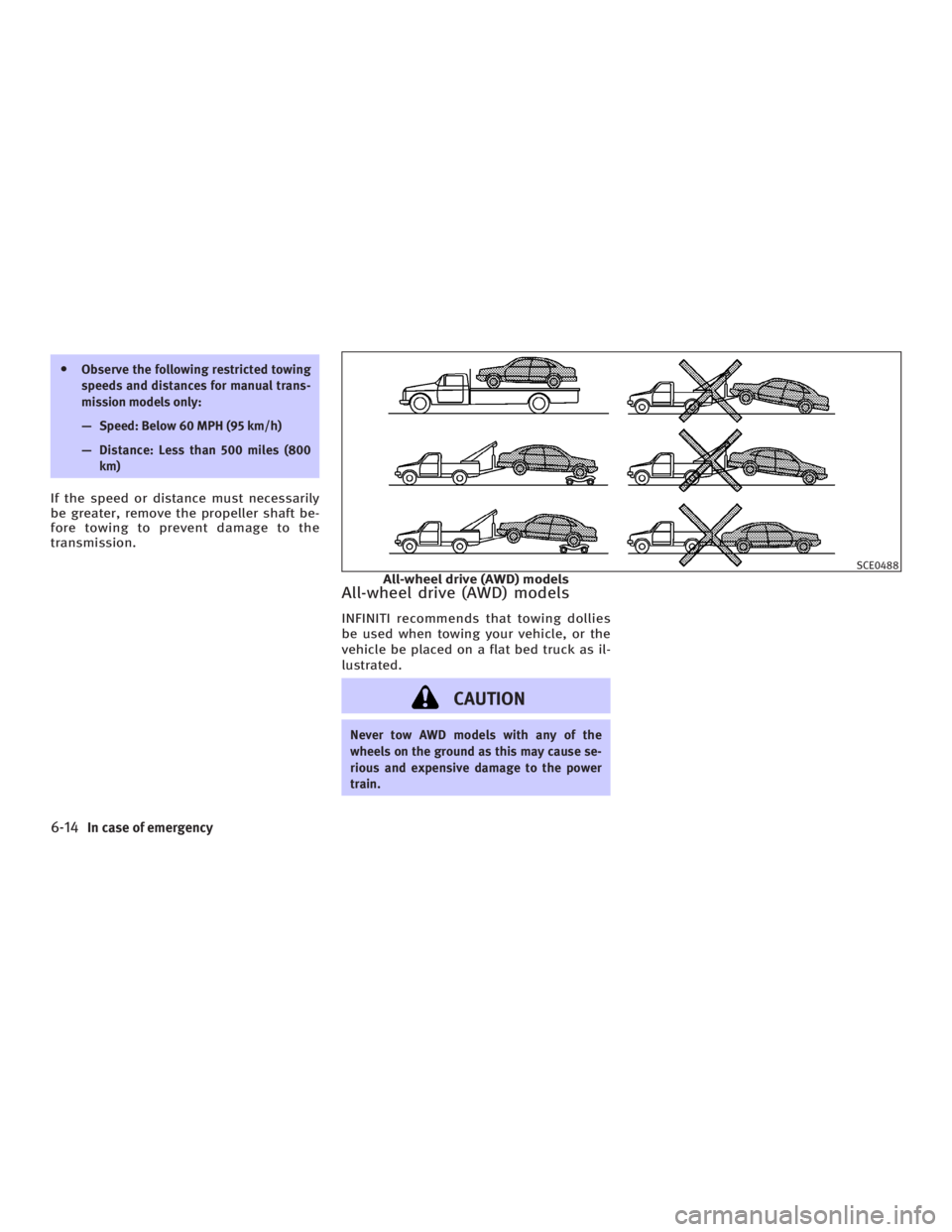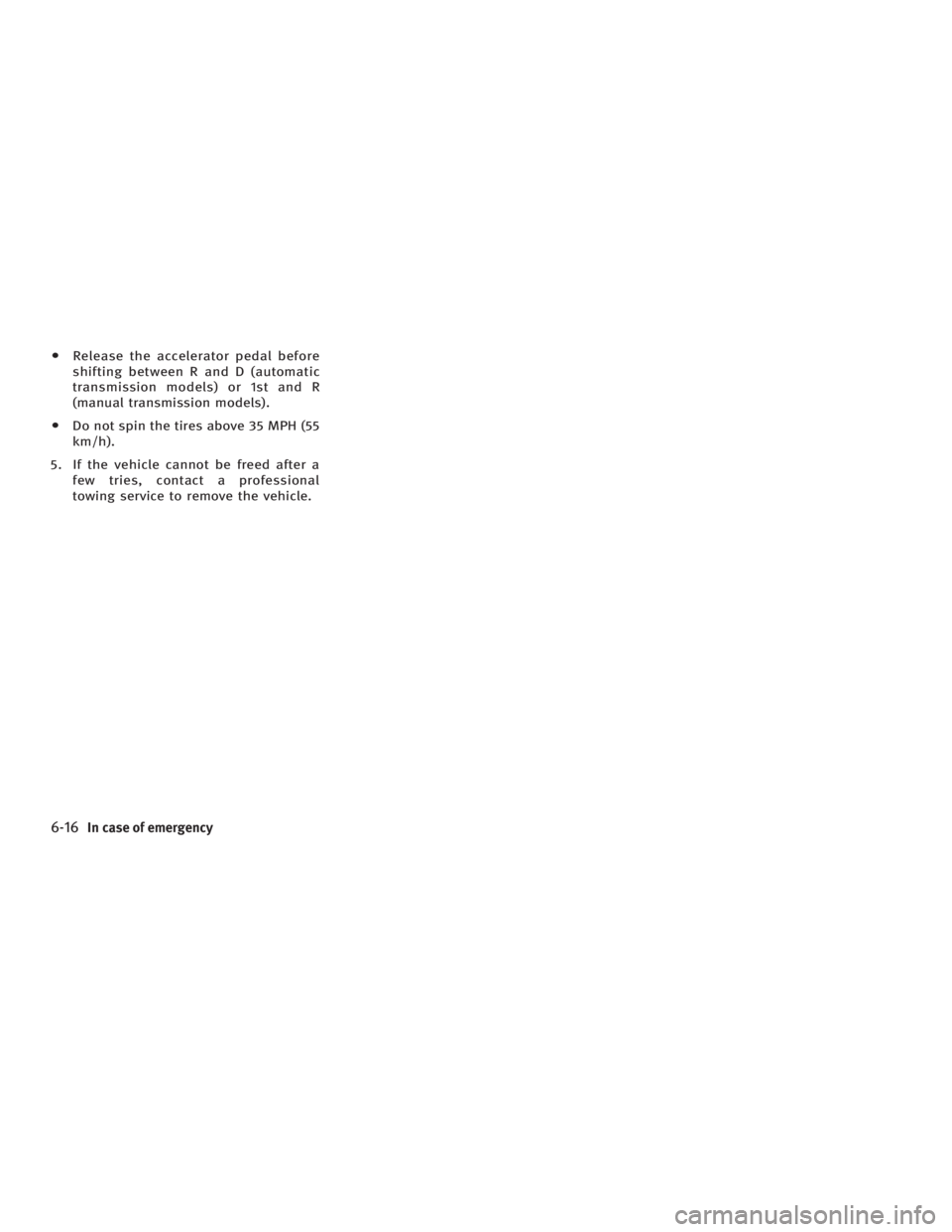2006 INFINITI G35 tow
[x] Cancel search: towPage 249 of 344

the ground or place the vehicle on a flat
bed truck as illustrated.
CAUTION O Never tow automatic transmission
models with the rear wheels on the ground or four wheels on the ground
(forward or backward) as this may cause
serious and expensive damage to the
transmission. If it is necessary to tow the
vehicle with the front wheels raised, al-
ways use towing dollies under the rear
wheels.
O When towing rear wheel drive models
with the front wheels on the ground or
on towing dollies:
Turn the ignition key to the OFF position,
and secure the steering wheel in a
straight ahead position with a rope or
similar device. Never secure the steering
wheel by turning the ignition key to the
LOCK position. This may damage the
steering lock mechanism.
O If you have to tow manual transmission
models with the rear wheels on the
ground or four wheels on the ground (if
you do not use towing dollies):
O Always release the parking brake.
O Move the transmission shift lever to
the N (Neutral) position. SCE0387A
Automatic transmission (AT) models
In case of emergency
6-13
w 06.1.4/V35-D/V5.0
X
Page 250 of 344

O Observe the following restricted towing
speeds and distances for manual trans-
mission models only:
Ð Speed: Below 60 MPH (95 km/h)
Ð Distance: Less than 500 miles (800
km)
If the speed or distance must necessarily
be greater, remove the propeller shaft be-
fore towing to prevent damage to the
transmission.
All-wheel drive (AWD) models INFINITI recommends that towing dollies
be used when towing your vehicle, or the
vehicle be placed on a flat bed truck as il-
lustrated.
CAUTION Never tow AWD models with any of the
wheels on the ground as this may cause se-
rious and expensive damage to the power
train. SCE0488
All-wheel drive (AWD) models
6-14 In case of emergency
w 06.1.4/V35-D/V5.0
X
Page 251 of 344

VEHICLE RECOVERY (Freeing a
stuck vehicle) After removing the front license plate (or
the bumper cover), securely install the re-
covery hook
q 1
. (Located with jacking
tools.)
Reinstall the license plate on the lower fit-
ting point. WARNING O Stand clear of a stuck vehicle.
O Do not spin your tires at high speed. This
could cause them to explode and result
in serious injury. Parts of your vehicle
could also overheat and be damaged.
CAUTION O Tow chains or cables must be attached
only to the vehicle recovery hooks or
main structural members of the vehicle.
Otherwise, the vehicle body will be dam-
aged.
O Do not use the vehicle tie downs to free a
vehicle stuck in sand, snow, mud, etc.
Never tow a vehicle using the vehicle tie
downs or recovery hooks.
O Always pull the cable straight out from
the front of the vehicle. Never pull the ve-
hicle at an angle. O Pulling devices should be routed so they
do not touch any part of the suspension,
steering, brake or cooling systems.
O Pulling devices such as ropes or canvas
straps are not recommended for use in
vehicle towing or recovery.
If your vehicle is stuck in sand, snow,
mud, etc., use the following procedure:
1. Turn off the Vehicle Dynamic Control
(VDC) system.
2. Make sure the area in front and be-
hind the vehicle is clear of obstruc-
tions.
3. Turn the steering wheel right and left
to clear an area around the front tires.
4. Slowly rock the vehicle forward and
backward.
O Shift back and forth between R (re-
verse) and D (drive) (automatic trans-
mission models) or 1st (low) and R (re-
verse) (manual transmission models).
O Apply the accelerator as little as pos-
sible to maintain the rocking motion.SCE0524
In case of emergency
6-15
w 06.1.4/V35-D/V5.0
X
Page 252 of 344

O Release the accelerator pedal before
shifting between R and D (automatic
transmission models) or 1st and R
(manual transmission models).
O Do not spin the tires above 35 MPH (55
km/h).
5. If the vehicle cannot be freed after a
few tries, contact a professional
towing service to remove the vehicle.
6-16 In case of emergency
w 06.1.4/V35-D/V5.0
X
Page 255 of 344

REMOVING SPOTS Remove tar and oil spots, industrial dust,
insects, and tree sap as quickly as pos-
sible from the surface of the paint to
avoid lasting damage or staining. Special
cleaning products are available at an
INFINITI dealer or any automotive acces-
sory store.
UNDERBODY In areas where road salt is used in winter,
the underbody must be cleaned regularly.
This will prevent dirt and salt from
building up and causing underbody and
suspension corrosion. Before the winter
period and again in the spring, the under-
seal must be checked and, if necessary,
re-treated.
GLASS Use glass cleaner to remove smoke and
dust film from the glass surfaces. It is
normal for glass to become coated with a
film after the vehicle is parked in the hot
sun. Glass cleaner and a soft cloth will
easily remove this film. CAUTION When cleaning the inside of the windows, do
not use sharp-edged tools, abrasive
cleaners or chlorine-based disinfectant
cleaners. They could damage the electrical
conductors, radio antenna elements or rear
window defroster elements.
ALUMINUM ALLOY WHEELS Wash regularly, especially during winter
months in areas where road salt is used.
Salt could discolor the wheel if not re-
moved.
CHROME PARTS Clean all chrome parts regularly with a
non-abrasive chrome polish to maintain
the finish.
TIRE DRESSING INFINITI does not recommend the use of
tire dressings. Tire manufacturers apply a
coating to the tires to help reduce discol-
oration of the rubber. If a tire dressing is
applied to the tires, it may react with the
coating and form a compound. This com- pound may come off the tire while driving
and stain the vehicle paint.
If you choose to use a tire dressing, take
the following precautions:
O Use a water-based tire dressing. The
coating on the tire dissolves more
easily with an oil-based tire dressing.
O Apply a light coat of tire dressing to
help prevent it from entering the tire
tread/grooves (where it would be diffi-
cult to remove).
O Wipe off excess tire dressing using a
dry towel. Make sure the tire dressing
is completely removed from the tire
tread/grooves.
O Allow the tire dressing to dry as rec-
ommended by tire dressing manufac-
turer.
Appearance and care
7-3
w 06.1.4/V35-D/V5.0
X
Page 306 of 344

O Do not use abrasive cleaners when
washing the wheels.
O Inspect wheel rims regularly for dents or
corrosion. Such damage may cause loss
of pressure or poor seal at the tire bead.
O INFINITI recommends that the road
wheels be waxed to protect against
road salt in areas where it is used
during winter.
Spare tire (TEMPORARY USE ONLY
spare tire (T-type)) Observe the following precautions if the
T-type spare tire must be used, otherwise
your vehicle could be damaged or in-
volved in an accident.
CAUTIONO The T-type spare tire should be used only
for an emergency. It should be replaced by
a standard tire at the first opportunity.
O Drive carefully while the T-type spare tire
is installed.
Avoid sharp turns and abrupt braking
while driving. O Periodically check the T-type spare tire
inflation pressure, and always keep it at
60 psi (420 kPa, 4.2 bar).
O With the T-type spare tire installed, do
not drive your vehicle at speeds faster
than 50 MPH (80 km/h).
O When driving on roads covered with
snow or ice, the T-type spare tire should
be used on the front wheel and the origi-
nal tire used on the rear wheels (drive
wheels). Use tire chains only on the rear
two original tires (Sedan).
O
Tire tread of the T-type spare tire will wear
at a faster rate than the original tire. Re-
place the T-type spare tire as soon as the
tread wear indicators appear.
O Do not use the T-type spare tire on other
vehicles.
O Do not use more than one T-type spare
tire at the same time.
O Do not tow a trailer while the T-type
spare tire is installed. CAUTION O Do not use tire chains on a T-type spare
tire. Tire chains will not fit properly on
the T-type spare tire and may cause
damage to the vehicle.
O Because the T-type spare tire is smaller
than the original tire, ground clearance
is reduced. To avoid damage to the ve-
hicle do not drive over obstacles. Also do
not drive the vehicle through an auto-
matic car wash since it may get caught.
8-48 Maintenance and do-it-yourself
w 06.1.5/V35-D/V5.0
X
Page 307 of 344

9 Technical and consumer information Capacities and recommended fuel/lubricants ... 9-2
Fuel recommendation .................................. 9-3
Engine oil and oil filter recommendation ..... 9-5
Recommended SAE viscosity number .......... 9-6
Air conditioning system refrigerant and
lubricant recommendations ......................... 9-7
Specifications................................................... 9-8
Engine......................................................... 9-8
Wheels and tires ......................................... 9-9
Dimensions and weights ............................. 9-9
When traveling or registering your vehicle in
another country .............................................. 9-10
Vehicle identification ...................................... 9-10
Vehicle identification number (VIN) plate ... 9-10
Vehicle identification number (Chassis
number) ..................................................... 9-10
Engine serial number ................................. 9-11
F.M.V.S.S./C.M.V.S.S. certification label ..... 9-11
Emission control information label ............. 9-12
Tire and loading information label ............. 9-12
Air conditioner specification label .............. 9-13 Installing front license plate............................ 9-13
Vehicle loading information ............................ 9-14
Terms ........................................................ 9-14
Vehicle load capacity ................................. 9-15
Loading tips ............................................... 9-17
Measurements of weights .......................... 9-17
Towing a trailer ............................................... 9-18
Maximum load limits ................................. 9-18
Towing load/specification chart ................. 9-19
Towing safety ............................................ 9-19
Flat towing ................................................ 9-22
Uniform tire quality grading............................ 9-23
Emission control system warranty .................. 9-24
Reporting safety defects (US only) .................. 9-24
Readiness for inspection/maintenance (I/M)
test (US only).................................................. 9-25
Event data recorders ...................................... 9-26
Owner's Manual/Service Manual order
information ................................................... 9-26
In the event of a collision.......................... 9-27
w 06.1.4/V35-D/V5.0
X
Page 312 of 344

Selecting the correct oil filter Your new vehicle is equipped with a high-
quality genuine NISSAN oil filter. When re-
placing, use the genuine oil filter or its
equivalent for the reason described in
change intervals.
Change intervals The oil and oil filter change intervals for
your engine are based on the use of the
specified quality oils and filters. Oil and
filter other than the specified quality, or
oil and filter change intervals longer than
recommended could reduce engine life.
Damage to engines caused by improper
maintenance or use of incorrect oil and
filter quality and/or viscosity is not cov-
ered by the new INFINITI vehicle limited
warranties.
Your engine was filled with a high quality
engine oil when it was built. You do not
have to change the oil before the first rec-
ommended change interval. Oil and filter
change intervals depend upon how you
use your vehicle. Operation under the fol-
lowing conditions may require more fre-
quent oil and filter changes.
O repeated short distance driving at cold
outside temperatures O driving in dusty conditions
O extensive idling
O towing a trailer
O stop and go commuting
Refer to the ªINFINITI Service and Mainte-
nance Guideº for the maintenance sched-
ule.
RECOMMENDED SAE VISCOSITY
NUMBER
SAE 5W-30 viscosity oil is preferred for all
ambient temperatures. SAE 10W-30,
10W-40 viscosity oil may be used if the am-
bient temperature is above 0ÉF (þ18ÉC). TI1028-C
9-6 Technical and consumer information
w 06.1.4/V35-D/V5.0
X